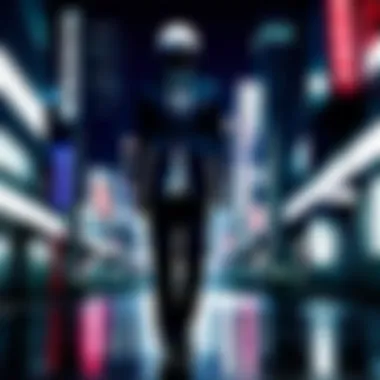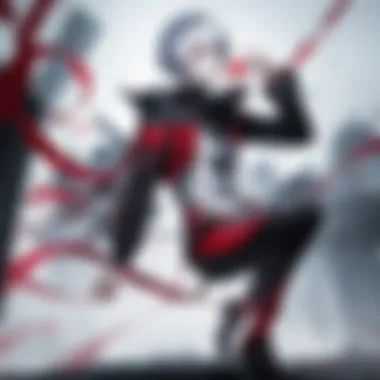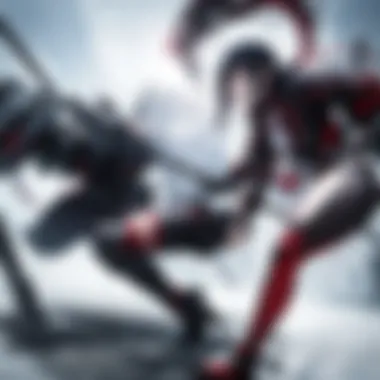Exploring Tokyo Ghoul: Themes and Online Access


Preface to the Series
Tokyo Ghoul is a riveting tale that plunges viewers into a dark and harrowing world where flesh-eating beings known as ghouls lurk just beneath the surface of society. Originally a manga created by Sui Ishida, it made its anime debut in July 2014. This series straddles the line between horror, action, and psychological thriller, creating a potent mix that resonates strongly with fans. The story follows Kaneki Ken, an ordinary college student who finds himself caught up in an extraordinary situation after a chance encounter with a ghoul.
The broader context of Tokyo Ghoul is steeped in themes of identity, humanity, and survival. Upon its release, it garnered immediate attention, with many praising its unique approach to the vampire trope. Ghouls, unlike traditional monsters, are depicted with depth and complexity, raising questions about morality and what it means to be human. The series quickly escalated in popularity, leading to a sequel, Tokyo Ghoul:re, which continued Kaneki's saga and expanded the universe.
The reception was largely positive, but not without its share of critiques. Many fans appreciated the character development and intricate storytelling, while some expressed disappointment over the adaptation choices made in the anime. Nonetheless, Tokyo Ghoul's cultural impact has been undeniable, setting a benchmark in the anime space, making it a must-watch for enthusiasts and new viewers alike.
"Tokyo Ghoul redefined the parameters of storytelling in modern anime, blending horror with profound existential themes."
The series became a focal point for discussions around morality and the variations of good and evil, pushing ideals of empathy and understanding amid chaos and violence. As we journey further into the article, we shall delve deep into Tokyo Ghoul's character arcs, thematic richness, and the guided pathways to access this captivating series online.
Background of Tokyo Ghoul
The story of Tokyo Ghoul begins not just as a tale of horror and fantasy, but as a reflection of societal complexities and individual struggles. Understanding the background of this compelling series sets the stage for appreciating its themes, character developments, and overall impact on the anime and manga landscape. This section aims to shed light on the origins of the manga, its subsequent adaptation into anime, and the cultural reception that has made it a staple in contemporary discussions about animation and storytelling.
Origins of the Manga
Tokyo Ghoul was first serialized in Weekly Young Jump by Sui Ishida starting in 2011. The manga quickly gained traction due to its unique blend of horror elements with psychological depth. At its core, it grapples with the notion of duality: what it means to be human versus the creature-like beings called ghouls. These characters navigate a world filled with tension, fear, and deep-rooted mistrust, which resonates strongly with societal issues today.
One of the pivotal strengths of the manga is how it humanizes its ghouls, showcasing them not merely as monsters but as beings filled with emotion, conflict, and desperation. This humanization invites readers to contemplate their own perceptions of morality and identity, asking questions like "What makes a monster?" and "Who truly holds the power in society?"
Transition to Anime Adaptation
In 2014, Tokyo Ghoul transitioned from manga to anime, courtesy of Studio Pierrot. While the initial adaptation garnered attention due to its intense and gruesome visuals, faithful fans of the manga noted several alterations in storytelling and character development. The anime introduced its audience to the dark, gritty realm of ghouls and humans without losing the essence of the source material, but it did face criticism for not fully exploring the manga’s depth, especially in character arcs.
Tokyo Ghoul's animation style was particularly striking, with vivid color palettes and fluid, dynamic fight sequences that brought its universe to life. These visual elements provided not only engagement but an emotional connection to the characters’ tumultuous journeys. Key themes like internal struggle and survival were visually depicted with poignant imagery – a hallmark of effective anime storytelling.
Cultural Impact and Reception
The impact of Tokyo Ghoul extends beyond just being another title in the realm of anime. It has sparked conversations around mental health, identity, and acceptance. Fans often find themselves drawn into discussions about its darker themes and the moral dilemmas faced by characters like Kaneki Ken, who embodies the struggles of finding one's place in a world that can often feel hostile and unforgiving.
Critics have noted that Tokyo Ghoul serves as a mirror reflecting societal fears and frustrations, which added to its popularity. The series received nominations and awards that highlight its influence, including a dedicated fanbase that actively engages in discussions across platforms like Reddit and various social media sites. The emotional depth, coupled with its psychological elements, has enabled Tokyo Ghoul to transcend mere entertainment, prompting philosophical musings that linger long after viewing.
"Tokyo Ghoul doesn’t just portray violence; it questions the very humanity of its characters and, by extension, the viewers themselves."
In summary, the background of Tokyo Ghoul is crucial for understanding its evolution and significance. It lays the foundation for an exploration of its intricate plot, character development, and online accessibility that will be further discussed in the sections to follow.
Plot Overview
The plot overview serves as a crucial building block in understanding Tokyo Ghoul. It encapsulates the essence of the narrative while unraveling the intricate layers that make this series compelling. The importance of outlining the plot lies in both clarifying the storyline and highlighting the thematic and character elements that resonate with viewers. A well-constructed plot overview not only enhances the viewing experience but also allows audiences to delve deeper into the subtleties of the unfolding drama.
Setting and World-Building
The Tokyo Ghoul universe is marked by a duality that reflects both the human and ghoul worlds. The setting draws in the audience through a detailed portrayal of Tokyo, where the bustling urban life contrasts sharply with the dark, hidden society of ghouls. This world-building is not merely for atmosphere; it lays the groundwork for the series' central conflicts.
The dichotomy of humans and ghouls speaks volumes about the inherent struggles within the human psyche. The careful crafting of locations—from high-rise buildings to the shadowy back alleys—paints a vivid backdrop for the characters' journeys. Every corner of Tokyo is imbued with an eerie sense of dread, compelling viewers to ponder not only the survival of its inhabitants but also the moral implications of their actions.
Key elements of the setting include:
- The stark contrast between the public and hidden societies.
- The depiction of horror inflected spaces, which mirrors the psychological turmoil within characters.
- The use of urban landscapes as a canvas to explore existential themes.
Main Story Arcs
The heart of Tokyo Ghoul beats strong through its story arcs. Each arc is integral to the overall progression of the plot and character development, providing various lenses through which to view the dilemmas faced by ghouls and humans alike. Key arcs guide the viewer through Kaneki's transformative journey—each arc peeling back layers of his character while escalating tensions between different factions.
For instance, the story reveals the shift from Kaneki's simplistic views on life to a more complex understanding of his identity as both human and ghoul. This transformation mirrors the series' exploration of themes like prejudice and acceptance.


Highlighted story arcs:
- The introduction of Kaneki as a regular college student, thrust into chaos.
- His development into a conflicted individual, faced with grave choices.
- The influence of powerful characters like Rize and their impact on his evolution.
Key Conflicts and Resolutions
Tokyo Ghoul thrives on its intense conflicts, both external and internal. The battles between humans and ghouls act as a primary driver of the plot, showcasing violence and the quest for survival intertwined with deep philosophical questions. Kaneki’s journey is rich with inner turmoil as he grapples with his identity—caught between the two worlds and the consequences of his dual existence.
The resolutions throughout the series often highlight the gray areas of morality. Characters confront dilemmas that force them to evaluate values, principles, and their survival instincts, which adds a rich layer of complexity.
"In Tokyo Ghoul, conflict serves as both a catalyst for action and a reflection of the characters' struggles with their darker selves."
From the escalated confrontations with the Anti-Ghoul Organization to his direct interactions with other ghouls, Kaneki exemplifies the swirling chaos and emotional weight born from these conflicts. The nuances in resolutions prompt viewers to consider not only who wins the fights but what they signify in broader terms—forgiveness, loss, acceptance.
In summary, a detailed plot overview illuminates the compelling elements of Tokyo Ghoul—from its richly developed setting and pivotal story arcs to the engaging conflicts that invite thoughtful reflection on the nature of humanity and otherness.
Character Analysis
Character analysis is a significant aspect in the exploration of Tokyo Ghoul. It's not just about the personal journeys and developments of the main figures; it also addresses the broader implications of their choices and their impact on the narrative. By dissecting these characters, we can uncover essential themes, societal issues, and the emotional resonance that makes this series so captivating for its audience. This section provides valuable insights into how each character shapes the story, engages viewers, and represents various ideologies that are pertinent to the human condition.
Kaneki Ken: Development and Transformation
Kaneki Ken is the protagonist whose evolution is central to Tokyo Ghoul. Initially, he presents as a timid and bookish university student. However, after a brutal encounter with Rize Kamishiro, his life takes a dark turn. The transformation from a human to a half-ghoul symbolizes not only a physical change but a profound psychological shift. Faced with the tendencies of both human and ghoul identities, Kaneki's character arc reflects a struggle for self-acceptance.
Throughout the series, he grapples with several existential questions. Is he a monster for needing to consume flesh to survive? Or does his humanity lie in his ability to empathize and connect with others? His development from a passive individual to a furiously determined survivor resonates with many viewers, making them question their own identities in the process. Kaneki's internal conflicts are further accentuated through dramatic visuals and intensive scenes, showcasing his growth through pain and suffering.
Rize Kamishiro: The Catalyst
Rize Kamishiro serves a pivotal role in Tokyo Ghoul as the catalyst for Kaneki's transformation. Her character, although she exists primarily in the shadows of Kaneki's mind, embodies the very essence of ghoul nature. The initial allure she presents draws Kaneki into a nightmarish reality, forcing him to confront terrifying truths about survival and predation.
Rize's role emphasizes the duality of attraction and terror. On one hand, she represents desire and freedom; on the other hand, she symbolizes death and chaos. Her existence in the narrative urges viewers to consider the complexity of desire and the darker motivations that often lie beneath the surface. Rize's character serves as a reminder of what is at stake when one embraces their inner demons, as she embodies both the allure and the horror of the ghoul existence.
Supporting Cast and Their Roles
The supporting cast in Tokyo Ghoul plays an indispensable role in enriching the narrative. Characters such as Touka Kirishima, Shuu Tsukiyama, and others each add layers of complexity to the story.
- Touka Kirishima broadens Kaneki's understanding of the ghoul community, serving as both ally and mirror. Her fierce persona contrasts with Kaneki’s initial meekness, pushing him toward growth.
- Shuu Tsukiyama, the self-proclaimed gourmet ghoul, injects both humor and a distinct perspective on predation. His flamboyant personality and unique philosophy on feeding illuminate the notion of enjoyment in predation, raising moral questions about the nature of consumption.
Supporting characters in Tokyo Ghoul show that the struggle for identity and survival doesn't just rest on Kaneki’s shoulders. Each brings their own stories and conflicts, making the narrative more robust. This ensemble reflects the multitude of human experiences: from struggles for acceptance to the quest for power. Through their interactions with Kaneki and each other, they shape the series’ core themes while highlighting the complexities of human, and ghoul, nature.
Understanding these characters and their roles deepens the appreciation of Tokyo Ghoul, enriching the viewing experience for enthusiasts.
Themes and Symbolism
Understanding the themes and symbolism present in Tokyo Ghoul is vital for appreciating the intricate layers of this anime. The show doesn't merely entertain; it challenges viewers to confront the essence of identity, the nature of humanity, and the societal constructs that influence our lives. By exploring these themes, one gains a deeper comprehension of the narrative's motivations and the characters' journeys, enhancing the overall viewing experience.
Identity and Humanity
One of the most profound themes in Tokyo Ghoul is the exploration of identity and the struggle between being human and being a ghoul. The protagonist, Kaneki Ken, undergoes a significant transformation, grappling with his dual identity. Initially, he’s a seemingly ordinary human who later becomes half-ghoul after a fateful encounter with Rize Kamishiro. This internal conflict mirrors the struggles many individuals face in contemplating their own identity in a society that often demands conformity.
The question of what it means to be human goes beyond the surface. It prompts viewers to reflect: do our actions define us, or is it our nature? Kaneki's journey encapsulates the essence of these inquiries, revealing that one's identity is often shaped by experiences and relationships. It begs the audience to consider the inherent qualities that characterize humanity—empathy, compassion, and the capacity for violence—and how these can coexist within a person.
Survival and Violence
Another critical theme embedded in Tokyo Ghoul is survival, which often takes a violent turn. In a world where ghouls prey on humans for sustenance, the instincts for survival can lead to brutal outcomes. Both ghouls and humans are driven by their basic need to exist, which manifests through acts of violence.
The relentless pursuit of survival forces characters to make morally ambiguous choices. For instance, Kaneki initially struggles with his need to eat human flesh while grappling with his moral compass; he embodies the conflicts inherent in the survival instinct. As tensions escalate between ghouls and humans, viewers witness how violence serves as a means to an end, pushing the characters into a web of ethical dilemmas that merit contemplation.
"Tokyo Ghoul pushes the boundaries of what it means to survive, blurring the lines between predator and prey."
This theme is particularly resonant in contemporary discussions about humanity's capacity for violence in the name of survival and the consequences that arise from such actions. Are these acts justified if they come from a place of necessity? The anime forces viewers to confront such uncomfortable questions.


Societal Commentary
Tokyo Ghoul serves as a rich commentary on society, exploring themes of discrimination, alienation, and the struggle for acceptance. Ghouls, despite being sentient beings, are often marginalized and viewed as monsters, which speaks volumes about societal tendencies to ostracize those who are different.
This commentary resonates with many real-world issues. The narrative parallels struggles faced by various communities around the globe. The ghouls’ plight can reflect the experiences of marginalized groups who are often dehumanized based on their differences. The divide between humans and ghouls symbolizes the barriers created by fear, misunderstanding, and prejudice.
The juxtaposition of ghouls and humans is critical in showcasing how superficial perceptions can lead to conflict and hatred. The audience is compelled to examine their own biases as Tokyo Ghoul challenges them to empathize with its characters, regardless of their nature. It draws attention to the complexity of societal dynamics, urging viewers to question what lies beyond the labels we ascribe to one another.
Artistic Elements
Artistic elements play a crucial role in shaping the overall impact of Tokyo Ghoul. They contribute to the storytelling, evoke emotions, and create a unique identity for the series. The attention to detail in the animation, along with an evocative soundtrack, enhances the viewer's experience. This section delves into three primary aspects: animation style and techniques, musical composition, and character design with visual symbolism.
Genre conventions in anime often set a specific tone, and Tokyo Ghoul manages to both adhere to and deviate from these norms. The dark themes and the contrasting instances of beauty and horror make the artistic choices particularly significant.
Animation Style and Techniques
The animation style of Tokyo Ghoul is notable for its blending of traditional hand-drawn artistry with modern techniques. Each episode infuses movement and emotion into its scenes. The fight sequences are especially compelling; they employ dynamic shot angles and fluid motion. This is paramount when illustrating the visceral nature of the conflicts that the characters face. For example, the battle against the ghouls often uses sharp cuts and rapid pacing, heightening the tension during these moments.
Moreover, the color palette plays a vital role. Darker hues dominate the series, reflecting the psychological turmoil experienced by the protagonist, Kaneki. The use of red often symbolizes danger and bloodshed, an appropriate nod to the gruesome events that unfold.
In contrast, softer colors emerge during moments of introspection and vulnerability. This duality not only enhances the visual experience but allows viewers to connect deeply with the emotional arcs of the characters.
Soundtrack and Musical Composition
Music in Tokyo Ghoul is not just an auditory embellishment; it’s integral to the storytelling. The soundtrack, composed by Yamamoto Yoshiaki, effectively complements the atmospheric tone of the series. Those who pay close attention will notice how the music elevates critical scenes, amplifying emotions and tension.
Several tracks stand out, especially the opening themes. They effectively capture the essence of the characters' struggles and the overarching themes of identity and survival. The haunting melody of "Unravel" by TK from Ling Tosite Sigure encapsulates Kaneki's inner conflict, merging lyrics and mood in a poignant manner.
Additionally, the score during fight scenes relies on a blend of orchestral elements and electronic sounds that create a sense of urgency and chaos. This musical composition showcases how sound can shape viewer emotions, ultimately enhancing engagement with the narrative.
Character Design and Visual Symbolism
Character design in Tokyo Ghoul serves much more than mere aesthetics; it reflects personalities, motivations, and hidden struggles. Kaneki’s evolution throughout the series is mirrored visually — from his initial, vulnerable self to a more menacing form as he embraces his half-ghoul nature.
The ghoul characters often possess exaggerated features. This visual choice symbolizes their predatory traits, diverging further from the human experience. Designs incorporate unique elements, like Rize's striking eyes, which convey both allure and danger. This contrast is deliberate, representing the duality of beauty and terror that defines the series.
Moreover, colors assigned to characters contribute to their symbolism. For instance, Kaneki's gradual shift from light colors to darker tones signifies his transformation, while Rize’s vibrant palette suggests both charm and volatility.
"Through artistic mastery, Tokyo Ghoul cultivates a narrative experience that transcends mere visuals, creating an immersive atmosphere that captures the essence of its themes and characters vividly."
These artistic elements are not just embellishments; they hold critical significance. They deepen the audience's understanding and emotional connection with the story, enriching the overall experience of Tokyo Ghoul. By engaging with animation, sound, and design, one can appreciate the profound artistry that enhances both the storyline and accessibility of this widely-loved anime.
Viewership and Accessibility
When discussing a series like Tokyo Ghoul, the conversations often veer towards the intricate themes and compelling characters. However, one crucial aspect that deserves attention is the topic of viewership and accessibility. This isn’t merely about how many people tune in; it’s about how easily viewers can access this popular anime. This section delves into streaming platforms, the difference between legal and illegal services, and the rich community engagement surrounding the series.
Platforms for Streaming
In this digital age, streaming platforms serve as the lifeblood for anime enthusiasts. For Tokyo Ghoul, several platforms have emerged as go-to destinations:
- Crunchyroll: Known for its extensive library of anime, Crunchyroll offers a variety of simulcast options, allowing viewers to watch episodes shortly after they air in Japan. Their viewer-friendly interface and high-quality streams make it a favorite.
- Funimation: This platform specializes in English dubbed anime and has a solid collection of Tokyo Ghoul. Including both subtitled and dubbed formats, it caters to diversely preferring audiences.
- Hulu: A broader streaming service that includes various television shows and movies, Hulu also features Tokyo Ghoul, appealing to those who are not solely anime fans.
- Netflix: As there are licenses depending on regions, Netflix occasionally showcases Tokyo Ghoul, providing a convenient option for existing subscribers.
Secondary platforms like HiDive and VRV also contribute to the accessibility of Tokyo Ghoul among different audiences.
Legal vs. Illegal Streaming Services
Understanding the difference between legal and illegal streaming options is vital for maintaining a healthy viewing environment. While the allure of free content from illegal websites might be tempting, it often results in unreliable streams, intrusive ads, and potential legal troubles.
Legal services provide a seamless experience with benefits such as:


- Quality Assurance: These platforms ensure high-definition streaming.
- Support for Creators: Every subscription or purchase helps support the anime industry, allowing creators to continue producing great content.
- Accessibility Features: Features like subtitles and dubbing enhance viewer experience for a wider audience.
Conversely, illegal streaming sites can lead to numerous drawbacks:
- Unreliable Access: They often go down or become inaccessible without notice.
- Security Risks: These sites can expose users to malware and hacking attempts.
- Ethical Considerations: Engaging with pirated content undermines the hard work put forth by creators, putting future projects at risk.
Community and Fan Engagement
The vibrant community around Tokyo Ghoul significantly enhances its viewing experience. Fans take to various platforms like Reddit and Facebook to discuss theories, share fan art, and dissect episodes. Engaging with fellow viewers can deepen understanding and appreciation of the series.
- Subreddit Engagement: The Tokyo Ghoul subreddit offers a space for fans to discuss not only the anime but manga as well, enabling rich discussions about character arcs and themes.
- Fan Events: Events such as anime conventions frequently feature Tokyo Ghoul-themed panels and cosplay competitions. They create opportunities for fans to meet and share their passion in person.
- Social Media: Platforms like Instagram and TikTok see fans share clips, memes, and artwork, creating a dynamic environment where community driven content thrives.
"Engagement in fan communities transforms passive viewership into an active journey, allowing individuals to connect on multiple levels with Tokyo Ghoul and its narrative worlds."
In essence, the accessibility of Tokyo Ghoul directly influences its popularity and cultural relevance. By understanding the available platforms, the implications of legal and illegal viewing, and the community's involvement, fans can enhance their experience while supporting the creators behind this iconic series.
Critical Reception
The critical reception of Tokyo Ghoul highlights the significance of its intricate storytelling, character dynamics, and thematic depth. This section draws attention to how the critics and audiences perceive the series, influencing not only its reputation but also its place in anime culture. Understanding these perspectives helps viewers appreciate the layers of meaning embedded in the narrative while acknowledging the varying responses it generates.
Critics' Reviews and Analysis
Critics initially received Tokyo Ghoul with notable enthusiasm. Many hailed its unique blend of horror and psychological elements. Reviews from reputable sources like Polygon and IGN often point out the series’ ability to oscillate between thrilling and disturbing moments, maintaining a balance that keeps the audience engaged. For instance, a reviewer from Anime News Network remarked on the character Kaneki's harrowing transformation, stating that it resonates profoundly with anyone grappling with identity crises.
However, some critiques emerged, especially regarding the pacing in later seasons, where viewers noted a decline in character development. This divided opinions among fans and critics alike, leading to discussions in forums like Reddit as individuals debated the merits and drawbacks of the show. Here are some key points from critical reviews:
- Strong Character Introduction: Critics laud Kaneki Ken's journey as reflective of deeper psychological struggles.
- Visual and Auditory Impact: The animation style and soundtrack have been praised for enhancing the eerie atmosphere.
- Inconsistencies in Pacing: Some reviewers express disappointment in the narrative flow, particularly in the follow-up seasons.
Audience Response and Fan Reviews
Fan responses to Tokyo Ghoul have been as diverse as the series itself. On platforms like Facebook and Reddit, enthusiasts often share their interpretations and emotional connections to the story. Many viewers express appreciation for its exploration of humanity through the lens of existential struggle, while others critique character motivations and plot developments. Notably, the character development of Rize Kamishiro has sparked discussions around the themes of desire and morality, leading to imaginative fan theories that circulate within the community.
Fans also engage in various creative pursuits inspired by the series, from detailed fan art to cosplay. These activities reflect a cult following that continues to thrive, illustrating that the series leaves a lasting impact on its audience. Here are some highlights from fan reviews:
- Engagement through Creative Content: Fans create art and fan fiction, expanding on character backstories.
- Discussion of Themes: Many forums light up with debates over the ethical dilemmas presented in the series.
- Mixed Emotional Reactions: Some viewers report being left with emotional turmoil after intense episodes, indicating the show's strong influence.
Awards and Recognitions
Tokyo Ghoul has earned several accolades that testify to its popularity and impact on the anime community. The series received nominations for prestigious awards, including the Tokyo Anime Award Festival, which recognizes outstanding work in the anime industry. Its impactful storytelling and captivating character arcs have positioned it as one of the most discussed anime titles of its time.
Some notable achievements include:
- Tokyo Anime Award Festival: Nominated for the Best Anime of the Year.
- Tokyo Anime Award - Audience Choice: Recognition for its fervent fanbase.
- Various Music Awards: Nominations for its unique soundtrack, enhancing the viewing experience.
In summation, the critical reception of Tokyo Ghoul encompasses a broad spectrum of viewpoints, ranging from high praise to critique. These discussions help illuminate the series’ complexities and its resonance within the anime community.
Epilogue
In this comprehensive guide, we've embarked on a detailed journey through the various facets of Tokyo Ghoul, exploring not only its intricate plotlines and rich characters but also the accessibility of the series for fans. The conclusion serves as a crucial wrap-up of our discussions, tying together the threads of narrative intricacies, character developments, and the ways audience engagement and accessibility intersect in the realm of this beloved anime.
Recap of Key Insights
The themes that pervade Tokyo Ghoul reflect broader societal issues—identity, corruption, and the struggle for acceptance. These elements resonate deeply with audiences, articulating universal truths these viewers often grapple with in their own lives.
- Identity Exploration: Kaneki's transformation represents a quest for self-understanding amidst chaos.
- Humanity vs. Monstrosity: The series blurs the lines, prompting viewers to consider what it truly means to be human.
- Accessibility: With the variety of platforms available for streaming, Tokyo Ghoul remains within reach, inviting new fans to immerse themselves in its story at their convenience.
As we dissected the streaming platforms, the stark contrast between legal and illegal sites highlighted both the complexities of content sharing and the ethical considerations of viewing habits today. It's important to support creators, ensuring they continue producing such meaningful narratives.
The Lasting Impact of Tokyo Ghoul
Tokyo Ghoul stands out not simply as another anime series, but as a cultural phenomenon that continues to influence both new works and its audience long after initial airing. The impact on viewers is profound, as it challenges norms and expectations within the anime genre, pushing the envelope for storytelling and character complexity.
- Revolutionizing Genres: Many series have drawn inspiration from Tokyo Ghoul, employing similar thematic elements and character dynamics in their storytelling.
- Fandom Evolution: The online community has exploded with discussions, fan art, and blogs dedicated to exploring its themes and characters, showcasing the active engagement of its viewers.
- Discussion on Nihilism and Philosophy: It stimulates conversations about deeper philosophical themes within modern anime, making it a staple of academic discourse among enthusiasts.
In summary, the importance of this conclusion can't be overstated. It encapsulates the necessity of understanding Tokyo Ghoul beyond its surface, inviting viewers to engage with its deeper themes and recognize its cultural relevance in today's society.















